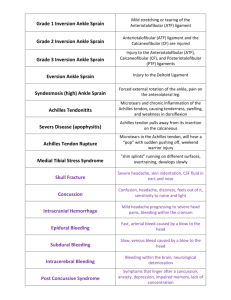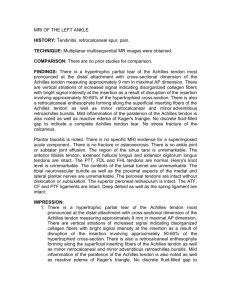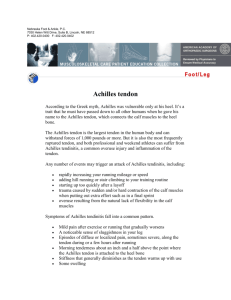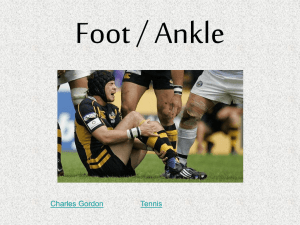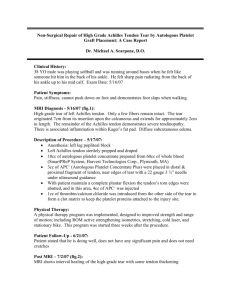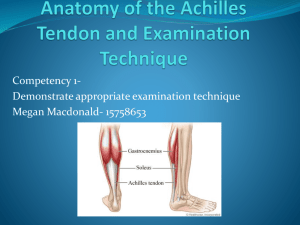A new measurement of heel-rise endurance with the ability
advertisement
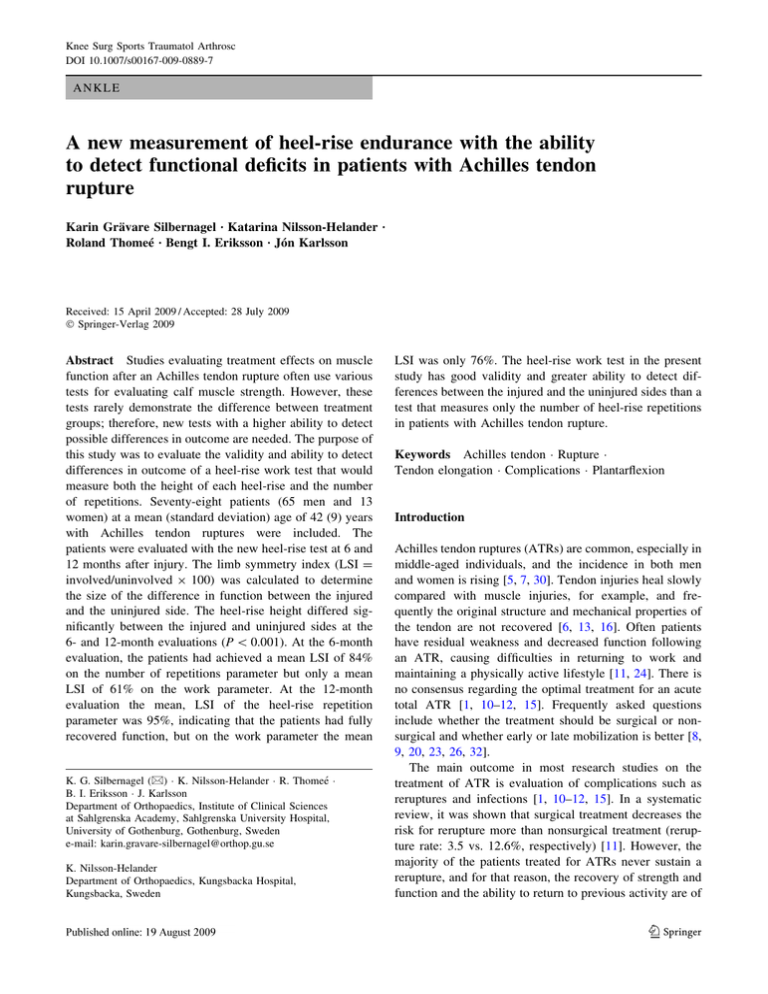
Knee Surg Sports Traumatol Arthrosc DOI 10.1007/s00167-009-0889-7 ANKLE A new measurement of heel-rise endurance with the ability to detect functional deficits in patients with Achilles tendon rupture Karin Grävare Silbernagel Æ Katarina Nilsson-Helander Æ Roland Thomeé Æ Bengt I. Eriksson Æ Jón Karlsson Received: 15 April 2009 / Accepted: 28 July 2009 Ó Springer-Verlag 2009 Abstract Studies evaluating treatment effects on muscle function after an Achilles tendon rupture often use various tests for evaluating calf muscle strength. However, these tests rarely demonstrate the difference between treatment groups; therefore, new tests with a higher ability to detect possible differences in outcome are needed. The purpose of this study was to evaluate the validity and ability to detect differences in outcome of a heel-rise work test that would measure both the height of each heel-rise and the number of repetitions. Seventy-eight patients (65 men and 13 women) at a mean (standard deviation) age of 42 (9) years with Achilles tendon ruptures were included. The patients were evaluated with the new heel-rise test at 6 and 12 months after injury. The limb symmetry index (LSI = involved/uninvolved 9 100) was calculated to determine the size of the difference in function between the injured and the uninjured side. The heel-rise height differed significantly between the injured and uninjured sides at the 6- and 12-month evaluations (P \ 0.001). At the 6-month evaluation, the patients had achieved a mean LSI of 84% on the number of repetitions parameter but only a mean LSI of 61% on the work parameter. At the 12-month evaluation the mean, LSI of the heel-rise repetition parameter was 95%, indicating that the patients had fully recovered function, but on the work parameter the mean K. G. Silbernagel (&) K. Nilsson-Helander R. Thomeé B. I. Eriksson J. Karlsson Department of Orthopaedics, Institute of Clinical Sciences at Sahlgrenska Academy, Sahlgrenska University Hospital, University of Gothenburg, Gothenburg, Sweden e-mail: karin.gravare-silbernagel@orthop.gu.se K. Nilsson-Helander Department of Orthopaedics, Kungsbacka Hospital, Kungsbacka, Sweden LSI was only 76%. The heel-rise work test in the present study has good validity and greater ability to detect differences between the injured and the uninjured sides than a test that measures only the number of heel-rise repetitions in patients with Achilles tendon rupture. Keywords Achilles tendon Rupture Tendon elongation Complications Plantarflexion Introduction Achilles tendon ruptures (ATRs) are common, especially in middle-aged individuals, and the incidence in both men and women is rising [5, 7, 30]. Tendon injuries heal slowly compared with muscle injuries, for example, and frequently the original structure and mechanical properties of the tendon are not recovered [6, 13, 16]. Often patients have residual weakness and decreased function following an ATR, causing difficulties in returning to work and maintaining a physically active lifestyle [11, 24]. There is no consensus regarding the optimal treatment for an acute total ATR [1, 10–12, 15]. Frequently asked questions include whether the treatment should be surgical or nonsurgical and whether early or late mobilization is better [8, 9, 20, 23, 26, 32]. The main outcome in most research studies on the treatment of ATR is evaluation of complications such as reruptures and infections [1, 10–12, 15]. In a systematic review, it was shown that surgical treatment decreases the risk for rerupture more than nonsurgical treatment (rerupture rate: 3.5 vs. 12.6%, respectively) [11]. However, the majority of the patients treated for ATRs never sustain a rerupture, and for that reason, the recovery of strength and function and the ability to return to previous activity are of 123 Knee Surg Sports Traumatol Arthrosc greater concern [1, 11, 23, 32]. In studies evaluating different treatment protocols for ATR, there is rarely a difference between treatment groups in recovery of function, despite the fact that the majority of patients with ATRs have strength deficits [9, 17, 23, 32, 34]. The strength deficit of the calf musculature after an ATR is approximately 10–30% on the injured side compared with the uninjured side, and the deficit appears to be difficult to overcome [10]. Gait abnormalities have also been found 24 months after injuries in patients with surgically treated ATRs [2]. This could indicate that regardless of treatment patients will have similar loss of function, or that the evaluation methods are not sensitive enough to detect possible differences. Therefore, before new treatments for ATR are evaluated, new methods for examining function should be developed and assessed to determine which has (have) the ability to detect even small, but clinically relevant, differences between treatments. The heel-rise test for muscular endurance is recommended as a measure of functional recovery after ATR and has often been used for evaluation in treatment studies [4, 17, 28, 31]. It is a reliable test and correlates well with isokinetic measurements [17, 22]. A disproportionate weakness in end-range plantar flexion was found by Mullaney et al. [21] and thought to result in decreased height of the heel-rise. Therefore, the height of the heel-rise may be an important variable, and several studies have included either a minimal height required for a successful heel-rise [4, 22, 31] or adjusted the test results based on the heel-rise height [28]. The inclusion of the heel-rise height might increase the ability of the test to register differences between treatments; however, we have not found any study that has evaluated the height of each heel-rise together with the number of heel-rises performed. We hypothesized that a test that evaluated the height of each heel-rise along with the number of repetitions would be more sensitive in detecting differences between the injured and uninjured sides and, therefore, a better outcome measure when comparing different treatment protocols. The purpose of this study is to examine this heel-rise test, to evaluate its validity and ability to detect differences in outcome and to compare this test to the test that will be only measuring number of repetitions as well as measures of ankle range of motion and patient-reported outcome. Materials and methods All patients received oral and written information about the purpose and procedure of the study, and written informed consent was obtained from them. Ethics approval was obtained from the Regional Ethical Review Board in Gothenburg, Sweden. This study is part of a larger research 123 project comparing surgical with nonsurgical treatment of ATR. Participants Seventy-eight patients with acute ATR were included in this prospective study. They were all from a cohort of 100 patients with ATR who were included in a randomized controlled trial (RCT) on surgical vs. nonsurgical treatment combined with early functional rehabilitation using a brace. The outcome of the RCT will be presented separately. Patients, 16–65 years of age, were included in the RCT if they suffered from an acute (within 72 h), closed, total ATR located in the mid-tendon substance. For the present study, we added the criterion that all data from both the 6- and the 12-month functional evaluations were available, and we excluded patients who had sustained a rerupture. As a result, 22 patients from the RCT were not included. Eight patients had a rerupture, two patients had a previous rupture on the contralateral side, three patients were nonadherent to the study protocol, and one patient developed an ankle contracture and could not be tested. Another four patients did not attend either the 6- or the 12month evaluation, and the testing equipment either malfunctioned or did not record the data for another four patients (two during the 6-month evaluation and two during the 12-month evaluation). Of the 78 patients included (65 men and 13 women), 43 received the same surgical treatment and 35 nonsurgical treatment. The mean [standard deviation (SD)] age was 42 (9) years, the mean (SD) height 178 (9) cm, and the mean (SD) weight was 85 (13) kg. The surgical procedure was performed with an open approach and consisted of an end-to-end suture using a modified Kessler technique. All patients were treated postoperatively or, in the nonsurgical group, immediately after injury with the ankle in equinus position, in a belowthe-knee plaster cast for 2 weeks followed by an adjustable brace (Don-Joy ROM-walker) for 6 weeks. The brace was set at free plantar flexion motion with dorsiflexion limited to -30° for the first 2 weeks, -10° for the next 2 weeks, and ?10° for the last 2 weeks. All patients followed an identical rehabilitation protocol supervised by two experienced physical therapists. Weight bearing was allowed with the ankle in a neutral position. The only disparity between the surgical and the nonsurgical groups was the surgical procedure. As a reference group, patients with chronic (symptoms for more than 3 months) painful Achilles tendinopathy in the midportion of the tendon were included. This group consisted of 38 patients (19 men and 19 women). These patients were evaluated using the same methods when entering the study and after 1 year. In this group, the mean Knee Surg Sports Traumatol Arthrosc (SD) age was 45 years (8), the mean (SD) height 177 cm (8), and the mean weight 79 kg (12). Procedure The evaluations were performed 6 and 12 months after injury. All evaluations were performed by two independent physical therapists. The patients’ height and weight were also measured and documented. The Achilles tendon Total Rupture Score (ATRS) was used to evaluate the patients’ symptoms and physical activity [25]. The ATRS ranges from 0 to 100, and a lower score indicates worse symptoms and greater limitation on physical activity. This is a reliable and valid patientreported outcome measure, which the patients completed prior to the functional evaluations. Ankle dorsiflexion range of motion was measured with a goniometer with the patient standing with the knee both straight and flexed that has been shown to have good reliability [3]. Care was taken to place the foot in a subtalar neutral position. The proximal arm of the goniometer was aligned with the midline of the fibula, the fulcrum with the lateral malleolus, and the distal arm parallel to the fifth metatarsal [27]. The heel-rise test for height and endurance The heel-rise test has been shown to be reliable in healthy persons and patients with ATR [22, 33]. The test has also been shown to be valid in patients with Achilles tendinopathy and able to detect clinically relevant differences in function between the injured and healthy leg and between the most symptomatic and the least symptomatic leg [29]. The MuscleLabÒ (Ergotest Technology) measurement system was used for the evaluations. MuscleLabÒ is a data collection unit to which different kinds of sensors can be connected. For the heel-rise test, a linear encoder was used. A spring-loaded string is connected to a sensor inside the linear encoder unit. When the string is pulled, the sensor outputs a series of digital pulses that are proportional to the distance travelled. The resolution is approximately one pulse for every 0.07 mm. By counting the number of pulses/time, the displacement as a function of time can be recorded and used to calculate velocity, force, and power (force times velocity). In this experiment, the spring-loaded string of the linear encoder was attached to the heel of the participant’s shoe (Fig. 1). All patients were given standardized instructions, and thereafter the test was demonstrated by the tester. Athletic footwear was standardized. Prior to testing, the patients warmed up by biking for five minutes on a stationary bicycle and then performed 3 sets of 10 two-legged toe raises. Fig. 1 Heel-rise test for endurance with the linear encoder attached to the heel of the shoe The heel-rise test for endurance was performed on one leg at a time with the participant standing on a box with an incline of 10°. The participants were allowed to place two fingertips per hand, at shoulder height, against the wall, for balance. A cassette player with a recorded voice that said ‘‘up’’ every 2 s was used to maintain the frequency of 30 heel-rises per minute. The participant was instructed to go as high as possible on each heel-rise and then lower the heel to the starting position and wait for the next ‘‘up’’ signal. The participant was asked to perform as many heel-rises as possible. The test was terminated when the patient stopped, could not maintain the frequency, or did not perform a proper heel-rise. The numbers of heel-rises as well as the height of each heel-rise and the total work (the body weight times total distance) in joules were used for data analysis. For documenting the heel-rise height, the maximal height performed during the test was used for evaluation. Statistical analysis All the data were analyzed using SPSS 15.0 for Windows. Descriptive data are reported as mean, SD, and range. The limb symmetry index (LSI) was calculated to determine the size of the difference in function between the 123 Knee Surg Sports Traumatol Arthrosc injured and uninjured side and for determining whether the difference was classified as normal or abnormal. The LSI was defined as the ratio between the involved limb score and the uninvolved limb score, expressed as a percentage (involved/uninvolved 9 100 = LSI). The LSI was used when comparing the results from different testing occasions. An LSI C 90% for an individual test was considered normal. The paired t-test was used to evaluate differences between the injured and uninjured sides and between the different testing occasions. Pearson correlation coefficient was used to evaluate the correlation between the heel-rise test and ankle range of motion. Because the ATRS presents ordinal data, the Spearman correlation coefficient was used to evaluate the correlation between the patient-reported symptoms (ATRS) and the heel-rise test and ankle range of motion. The level of significance was set at P \ 0.05. Results Patient-reported outcome—ATRS The patients (n = 78) had a mean (SD) ATRS of 72 (17) points at the 6-month evaluation and of 88 (15) points at the 12-month evaluation. Heel-rise height Figure 2 shows the comparisons in the heel-rise heights between the uninjured and injured sides in patients with ATRs. There was a significant difference in the heel-rise height between the injured and uninjured sides in the ATR patients at the 6-month evaluation (10.2 vs. 14.1 cm, Fig. 2 Heel-rise height (cm) results for both the injured and the uninjured side in patients with ATR at the 6- and 12-month evaluations. The results are given as mean and 95% CI 123 respectively; P \ 0.001) and at the 12-month evaluation (11.1 vs. 13.9 cm, respectively; P \ 0.001). On the injured side, there was a significant increase in height between the 6- and 12-month evaluations (10.2 vs. 11.1 cm, respectively; P \ 0.001); however, there was no change in heel-rise height on the uninjured side (14.1 vs. 13.9 cm, respectively; P = 0.207) (Fig. 2). In the reference group (patients with Achilles tendinopathy), there was no significant difference in heel-rise height between the injured and the uninjured side at the initial evaluation (12.0 vs. 12.1 cm, respectively; P = 0.824) or at the 12-month evaluation (12.4 vs. 12.3 cm, respectively; P = 0.573). Nor there were any significant changes in heel-rise height over time on each side. Heel-rise repetition and work Figures 3 and 4 show the comparisons in the heel-rise repetition and work between the uninjured and injured sides in patients with ATRs. For both the heel-rise repetition and heel-rise work, there were significant differences (P \ 0.02) between the injured and uninjured sides at the 6- and 12-month evaluations (Figs. 3, 4). Heel-rise test—LSI values From 6 to 12 months, the LSI improved for heel-rise height from 72 to 80% (P \ 0.001); for work from 61 to 76% (P \ 0.001) and for number of repetitions from 84 to 95% (P \ 0.001). The heel-rise test’s ability to detect deficits in function Figure 5 shows the ability of the different parameters of the heel-rise test to detect deficits in function. An LSI C 90% Fig. 3 Heel-rise repetition (number of repetitions) results for both the injured and the uninjured side in patients with ATR at the 6- and 12-month evaluations. The results are given as mean and 95% CI Knee Surg Sports Traumatol Arthrosc Table 1 Correlation between the heel-rise test, ankle range of motions test, and symptoms Correlation between measurements ATRS 6 months 12 months Heel-rise Height 0.268 (P = 0.018) 0.004 (P = 0.970) Reps Work 0.140 (P = 0.222) 0.314 (P = 0.005) 0.196 (P = 0.085) 0.159 (P = 0.164) Ankle range of motion Fig. 4 Heel-rise work (joule) results for both the injured and the uninjured side in patients with ATR at the 6- and 12-month evaluations. The results are given as mean and 95% CI Work 12m Knee straight 0.212 (P = 0.064) 0.038 (P = 0.741) Knee bent 0.163 (P = 0.156) -0.038 (P = 0.742) Table 2 Correlation between the heel-rise height and ankle range of motion Correlation between measurements Heel-rise height 6 months 12 months Ankle range of motion Work 6m Height 12m Height 6m Knee straight 0.212 (P = 0.064) -0.117 (P = 0.307) Knee bent 0.137 (P = 0.234) -0.006 (P = 0.957) Abnormal Normal Comparison with other measures Reps12m Correlation between heel-rise test, ankle range of motion, and symptoms (ATRS) Reps 6m 0% 10% 20% 30% 40% 50% 60% 70% 80% 90% 100% Fig. 5 The percentage of the patients classified as having achieved normal versus abnormal function on the different parameters of the heel-rise test for an individual test was considered normal. Normal function of the repetition parameter was achieved in 38% of the patients at 6 months and in 63% at 12 months. Normal function of the work and height parameters were achieved in 9 and 6% of the patients, respectively, at 6 months and only improved to 23 and 22%, respectively, at 12 months. Ankle range of motion The patients had a significantly lower ankle dorsiflexion range of motion with knee straight (KS) on the injured compared with the uninjured side at the 6-month evaluation (31° vs. 36°, respectively; P \ 0.001) and at the 12-month evaluation (33° vs. 36°, respectively; P \ 0.001). This was also found with the knee bent (KB) on the injured side compared with the uninjured side at the 6-month evaluation (34° vs. 41° respectively; P \ 0.001) and at the 12-month evaluation (37° vs. 41°, respectively; P \ 0.001). Between the 6- and 12-month evaluations, the range of motion did not change on the uninjured side but did increase significantly on the injured side, in both with KS (P = 0.001) and KB (P \ 0.001) tests. At the 6-month evaluation, the LSI of heel-rise work and heelrise height correlated significantly with patient-reported symptoms (ATRS), but there were no other significant correlations found either at the 6- or 12-month evaluation (Table 1). Correlation between heel-rise height and ankle range of motion The LSI of heel-rise height did not correlate significantly with the LSI of ankle range of motion at either the 6-month or the 12-month evaluation (Table 2). Discussion The heel-rise work test as described in the present study was demonstrated to have a good validity and a greater ability to detect differences between injured and uninjured side in patients with ATR than does a test that measures only the number of repetitions performed. We suggest that the measure of heel-rise work is used as an outcome measures because it combines the measure of height and muscular endurance. Tests that have good reliability, validity, and high sensitivity are important to use in studies when comparing the outcome of treatments, and this test 123 Knee Surg Sports Traumatol Arthrosc can therefore be recommended for use when comparing treatment options for ATR. The literature suggests the need for a balance between early motion with exercise and immobilization to avoid rerupture and possible tendon elongations with functional deficits (i.e., the tendon heals in a lengthened position) [8, 9, 21]. Excessive tendon elongation and rerupture are also described as two of the reasons for surgical revision following ATR [14, 35]. Studies have demonstrated that after Achilles tendon repair, tendon ends may separate [19]. Kangas et al. [8] have also shown that early motion resulted in a lesser degree of tendon separation than did immobilization after surgical treatment of an ATR. The degree of tendon separation also correlated with clinical outcome [8]. The excessive tendon lengthening is thought to cause increased ankle range of motion and weakness at the end range of plantar flexion. The present study shows that heel-rise height is affected by ATR, indicating that there is a weakness at the end range of plantar flexion. The heel-rise height measurement also appears to have good validity for evaluating functional deficits relating to ATRs, because the injured side had a significant decrease in height compared to the uninjured side, and the height of the uninjured side did not change over time. Furthermore, in patients with Achilles tendinopathy there were no significant differences in heel-rise height between the injured and the uninjured sides at both the initial evaluation and 1 year later; nor was there any change over time. The decreased heel-rise height that was shown in the present study could be due to tendon lengthening, although tendon length was not measured. Another study, which examined the mechanical properties of the Achilles tendon, has also taken into account the heel-rise height along with the number of repetitions and found that this correlated with the tendons’ modulus of elasticity [28]. Kangas et al. [8] also found a decrease in tendon elongation over time, which is in agreement with our finding of an increase in the heel-rise height on the injured side over time. In summary, the aspect of tendon elongation and heelrise height appears to be important aspects to evaluate in relation to both tendon healing and functional outcome after ATR and thus needs to be included when comparing various treatment options. Ankle range of motion is commonly described as an indirect measure when evaluating tendon elongation, expressed as increased active or passive dorsal flexion [14, 18]. Therefore we explored whether there was any relationship between ankle range of motion and the heel-rise height measured with the heel-rise work test. We found a reduction in dorsiflexion range of motion on the injured side compared with the uninjured side at the 6- and 12month evaluations. This finding is in contrast with the literature, suggesting that there is an increase in range of motion [14, 18]. Moreover, we found low, nonsignificant 123 correlations between heel-rise height and ankle range of motion, indicating that range of motion might not be an appropriate measure for evaluating tendon elongation. If the decreased heel-rise height that was shown in this study is due to tendon lengthening or calf muscle weakness, needs to be further evaluated. Most studies that use the heel-rise test as an outcome evaluate the number of repetitions performed. The results of the present study suggest, however, that measuring both the number of repetitions and the height of each heel-rise (total amount of work performed) are crucial when evaluating heel-rise endurance. For example, at the 6-month evaluation, the patients had achieved a mean LSI of 84% on the number of repetitions parameter but only a mean LSI of 61% on the work parameter. At the 12-month evaluation, the mean LSI of the heel-rise repetition parameter was 95%, indicating that the patients had fully recovered function, but on the work parameter the mean LSI was only 76%. This indicates that the function of the gastrocnemius–soleus–Achilles complex had not fully recovered after 12 months. However, the traditional method of evaluating the number of heel-rises did not detect the deficit. This inability of the heel-rise repetition parameter to detect deficits in function may partially explain why so few studies report any differences in function between various treatment options for ATR. The aspects of function measured by heel-rise endurance, running and jumping, and patient-reported outcomes need to be further evaluated in patients with ATR. It would also be worthwhile to assess whether patients adjust gait and/or running pattern in relation to the recovery of heelrise height and possible tendon elongation. When comparing heel-rise height to the patient-reported outcome as measured by the ATRS, we found a significant correlation at the 6-month but not at the 12-month evaluation. This suggests that recovery is complex and, therefore, should be evaluated with various measurements. We suggest that all treatment studies on ATR should evaluate patients with reliable, valid, and sensitive tests of various indicators of recovery, such as patient-reported outcome, strength, endurance, and return to previous activity level. Such a battery of tests will provide a more complete picture of recovery and optimal treatment following ATR. Complications also need to be reported, of course, but we do not believe this should be the main outcome. Conclusions In patients with ATR, a heel-rise test that measures both the height of each repetition and the number of repetitions has good validity and a greater ability to detect differences between the injured and uninjured sides than a test that Knee Surg Sports Traumatol Arthrosc measures only the number of repetitions. Therefore, we recommend adding this testing method to measures of patient-reported outcome when evaluating different treatment protocols in patients with ATR. Acknowledgments We thank physical therapist Annelie Brorsson for assistance with the evaluations. This study was supported by grants from the Swedish National Centre for Research in Sports (CIF), the local Research and Development Council of Halland, Sweden and Renée Eanders Foundation, Sweden. 17. 18. 19. References 20. 1. Bhandari M, Guyatt GH, Siddiqui F, Morrow F, Busse J, Leighton RK, Sprague S, Schemitsch EH (2002) Treatment of acute Achilles tendon ruptures: a systematic overview and metaanalysis. Clin Orthop Relat Res 400:190–200 2. Don R, Ranavolo A, Cacchio A, Serrao M, Costabile F, Iachelli M, Camerota F, Frascarelli M, Santilli V (2007) Relationship between recovery of calf-muscle biomechanical properties and gait pattern following surgery for Achilles tendon rupture. Clin Biomech (Bristol, Avon) 22:211–220 3. Ekstrand J, Wiktorsson M, Oberg B, Gillquist J (1982) Lower extremity goniometric measurements: a study to determine their reliability. Arch Phys Med Rehabil 63:171–175 4. Haggmark T, Liedberg H, Eriksson E, Wredmark T (1986) Calf muscle atrophy and muscle function after non-operative vs. operative treatment of Achilles tendon ruptures. Orthopedics 9:160–164 5. Houshian S, Tscherning T, Riegels-Nielsen P (1998) The epidemiology of Achilles tendon rupture in a Danish county. Injury 29:651–654 6. Józsa L, Kannus P (1997) Human tendons. Anatomy, physiology and pathology. Human Kinetics, Champaign 7. Järvinen TA, Kannus P, Paavola M, Järvinen TL, Jozsa L, Järvinen M (2001) Achilles tendon injuries. Curr Opin Rheumatol 13:150–155 8. Kangas J, Pajala A, Ohtonen P, Leppilahti J (2007) Achilles tendon elongation after rupture repair: a randomized comparison of 2 postoperative regimens. Am J Sports Med 35:59–64 9. Kangas J, Pajala A, Siira P, Hamalainen M, Leppilahti J (2003) Early functional treatment versus early immobilization in tension of the musculotendinous unit after Achilles rupture repair: a prospective, randomized, clinical study. J Trauma 54:1171–1180 10. Khan RJ, Fick D, Brammar TJ, Crawford J, Parker MJ (2004) Interventions for treating acute Achilles tendon ruptures. Cochrane Database Syst Rev (3):CD003674 11. Khan RJ, Fick D, Keogh A, Crawford J, Brammar T, Parker M (2005) Treatment of acute achilles tendon ruptures. A meta-analysis of randomized, controlled trials. J Bone Joint Surg Am 87:2202–2210 12. Kocher MS, Bishop J, Marshall R, Briggs KK, Hawkins RJ (2002) Operative versus nonoperative management of acute Achilles tendon rupture: expected-value decision analysis. Am J Sports Med 30:783–790 13. Leadbetter WB (1992) Cell-matrix response in tendon injury. Clin Sports Med 11:533–578 14. Leppilahti J, Forsman K, Puranen J, Orava S (1998) Outcome and prognostic factors of achilles rupture repair using a new scoring method. Clin Orthop Relat Res 346:152–161 15. Lo IK, Kirkley A, Nonweiler B, Kumbhare DA (1997) Operative versus nonoperative treatment of acute Achilles tendon ruptures: a quantitative review. Clin J Sport Med 7:207–211 16. Maffulli N, Ewen SW, Waterston SW, Reaper J, Barrass V (2000) Tenocytes from ruptured and tendinopathic achilles 21. 22. 23. 24. 25. 26. 27. 28. 29. 30. 31. 32. 33. 34. 35. tendons produce greater quantities of type III collagen than tenocytes from normal achilles tendons. An in vitro model of human tendon healing. Am J Sports Med 28:499–505 Moller M, Lind K, Movin T, Karlsson J (2002) Calf muscle function after Achilles tendon rupture. A prospective, randomised study comparing surgical and non-surgical treatment. Scand J Med Sci Sports 12:9–16 Mortensen HM, Skov O, Jensen PE (1999) Early motion of the ankle after operative treatment of a rupture of the Achilles tendon. A prospective, randomized clinical and radiographic study. J Bone Joint Surg Am 81:983–990 Mortensen NH, Saether J, Steinke MS, Staehr H, Mikkelsen SS (1992) Separation of tendon ends after Achilles tendon repair: a prospective, randomized, multicenter study. Orthopedics 15:899– 903 Movin T, Ryberg A, McBride DJ, Maffulli N (2005) Acute rupture of the achilles tendon. Foot Ankle Clin 10:331–356 Mullaney MJ, McHugh MP, Tyler TF, Nicholas SJ, Lee SJ (2006) Weakness in end-range plantar flexion after Achilles tendon repair. Am J Sports Med 34:1120–1125 Möller M, Lind K, Styf J, Karlsson J (2005) The reliability of isokinetic testing of the ankle joint and a heel-raise test for endurance. Knee Surg Sports Traumatol Arthrosc 13:60–71 Möller M, Movin T, Granhed H, Lind K, Faxen E, Karlsson J (2001) Acute rupture of tendon Achillis. A prospective randomised study of comparison between surgical and non-surgical treatment. J Bone Joint Surg Br 83:843–848 Nilsson-Helander K, Sward L, Silbernagel KG, Thomee R, Eriksson BI, Karlsson J (2008) A new surgical method to treat chronic ruptures and reruptures of the Achilles tendon. Knee Surg Sports Traumatol Arthrosc 16(6):614–620 Nilsson-Helander K, Thomee R, Gravare-Silbernagel K, Thomee P, Faxen E, Eriksson BI, Karlsson J (2007) The Achilles tendon total rupture score (ATRS): development and validation. Am J Sports Med 35:421–426 Nistor L (1981) Surgical and non-surgical treatment of Achilles tendon rupture. A prospective randomized study. J Bone Joint Surg Am 63:394–399 Norkin CC, White DJ (1985) Measurement of joint motion: a guide to goniometry. Davis, Philadelphia Schepull T, Kvist J, Andersson C, Aspenberg P (2007) Mechanical properties during healing of Achilles tendon ruptures to predict final outcome: a pilot Roentgen stereophotogrammetric analysis in 10 patients. BMC Musculoskelet Disord 8:116 Silbernagel KG, Gustavsson A, Thomee R, Karlsson J (2006) Evaluation of lower leg function in patients with Achilles tendinopathy. Knee Surg Sports Traumatol Arthrosc 14:1207–1217 Suchak AA, Bostick G, Reid D, Blitz S, Jomha N (2005) The incidence of Achilles tendon ruptures in Edmonton, Canada. Foot Ankle Int 26:932–936 Suchak AA, Bostick GP, Beaupre LA, Durand DC, Jomha NM (2008) The influence of early weight-bearing compared with non-weight-bearing after surgical repair of the Achilles tendon. J Bone Joint Surg Am 90:1876–1883 Suchak AA, Spooner C, Reid DC, Jomha NM (2006) Postoperative rehabilitation protocols for Achilles tendon ruptures: a meta-analysis. Clin Orthop Relat Res 445:216–221 Svantesson U, Österberg U, Thomeé R, Grimby G (1998) Muscle fatigue in a standing heel-rise test. Scand J Rehabil Med 30:67–72 Weber M, Niemann M, Lanz R, Muller T (2003) Nonoperative treatment of acute rupture of the achilles tendon: results of a new protocol and comparison with operative treatment. Am J Sports Med 31:685–691 Young JS, Kumta SM, Maffulli N (2005) Achilles tendon rupture and tendinopathy: management of complications. Foot Ankle Clin 10:371–382 123

